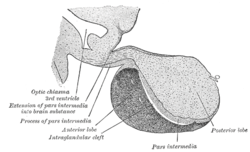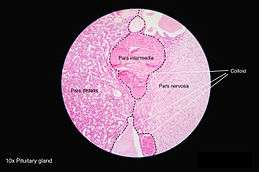Pars intermedia
Pars intermedia is the boundary between the anterior and posterior lobes of the pituitary. It contains three types of cells - basophils, chromophobes, and colloid-filled cysts. The cysts are the remainder of Rathke’s pouch.
| Pars intermedia | |
|---|---|
 Median sagittal through the hypophysis of an adult monkey. (Pars intermedia labeled at bottom center.) | |
| Details | |
| Identifiers | |
| Latin | pars intermedia adenohypophyseos |
| TA | A11.1.00.004 A09.4.02.017 |
| TH | H3.08.02.2.00007 |
| FMA | 74632 |
| Anatomical terminology | |

Pars intermedia is seen between pars distalis and pars nervosa.
In human fetal life, this area produces melanocyte stimulating hormone or MSH which causes the release of melanin pigment in skin melanocytes (pigment cells). However, the pars intermedia is normally either very small or entirely absent in adulthood.
In lower vertebrates (fish, amphibians) MSH from the pars intermedia is responsible for darkening of the skin, often in response to changes in background color. This color change is due to MSH stimulating the dispersion of melanin pigment in dermal (skin) melanophore cells.
External links
- Histology image: 14001loa – Histology Learning System at Boston University
- Histology image: 14101loa – Histology Learning System at Boston University
- Histology image: 38_11 at the University of Oklahoma Health Sciences Center
- UIUC Histology Subject 991
This article is issued from Wikipedia. The text is licensed under Creative Commons - Attribution - Sharealike. Additional terms may apply for the media files.